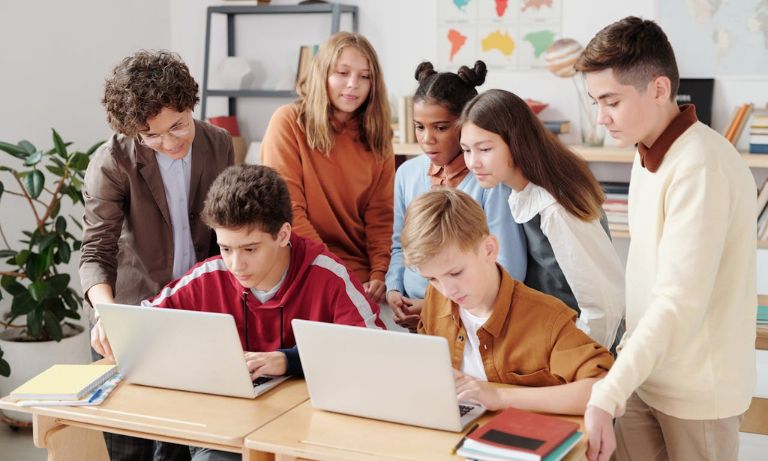A common experience occurs in many classrooms across the globe: a student doesn’t fully grasp a concept until it’s presented in a different way. It can be visually, physically, or through discussion, but a simple didactic classroom lesson typically won’t do.
Learning isn’t linear, and most students benefit from engaging with information in multiple ways. This is where multimodal learning proves its value.
What is Multimodal Learning?
At its core, multimodal learning is an educational approach that integrates two or more ways – or modes – of delivering information to students. Think beyond just listening to a lecture or reading a textbook. It’s about seeing, hearing, touching, doing, and even experiencing to reach students with different learning preferences.
Common sensory modes involved in multimodal learning include:
- Visual:diagrams, pictures, colours, videos, infographics
- Auditory:lectures, discussions, music, sound effects
- Reading/Writing:textbooks, worksheets, written instructions
- Kinaesthetic:hands-on activities, experiments, role-playing, building models
This approach recognises that every learner is unique. While some students might excel by listening to an explanation (auditory), others might grasp a concept more readily by seeing it demonstrated visually, or by physically interacting with the material (kinaesthetic). By providing a variety of sensory inputs, we significantly increase the chances of information being understood, retained, and recalled by a wider range of students.

Why is Multimodal Learning Important?
Recent research and statistics reinforce the growing impact of multimodal learning in Australian classrooms and beyond. By integrating diverse modes, educators unlock many benefits for the development of each student.
1. Stronger memory and higher achievement
A comprehensive 2023 study highlights that when students learn through multiple senses, their brains create stronger, more integrated memories. In one experiment, eight-year-olds learning a new language had 73% better recall when they used their hands and bodies to mimic words, compared to more passive approaches.
2. Universal benefits across learning styles
A 2025 study in science education found that multimodal strategies significantly improved learning outcomes, regardless of whether students preferred visual, auditory, or kinaesthetic styles. This means that all students benefit even if they have different learning preferences. These findings challenge the notion of tailoring content solely to individual learning styles and instead support a blended approach.
3. Better engagement and accessibility
When students are engaged through various modes, boredom drops, and motivation rises. Multimodal learning also makes content more accessible, particularly for students with differing abilities or English as an additional language, as multiple pathways allow learners to access information in the format that suits them best.
4. Prevalence of multimodal learners
A review across multiple studies shows that nearly half of young adults gravitate naturally toward a multimodal learning preference. This means they learn best when several senses are engaged at once rather than through a single channel.
How to Implement Multimodal Learning in the Classroom
Implementing multimodal learning strategies can revolutionise anyone’s teaching or parenting approach. Here are some tried-and-tested strategies:
- Mix It Up:Combine videos, images, written tasks, hands-on projects, and oral presentations in lessons.
- Collaborative Activities:Group students for presentations, debates, and role-plays that bring content to life.
- Use Multimedia Tools:Interactive whiteboards, apps, and online simulations appeal to tech-savvy kids while supporting different modes.
- Real-life Examples:Connect lessons to situations students experience in the real world.
- Games and Simulations: Educational games blend fun with learning and often require reading, listening, discussing, and acting.
Examples of Multimodal Learning
Here are some examples of multimodal learning in action:
- A geography unit uses maps (visual), documentaries (auditory), student reports (reading/writing), and a model volcano build (kinaesthetic).
- In English class, a novel study includes reading chapters (reading/writing), acting out scenes (kinaesthetic), discussing themes (auditory), and creating mood boards (visual).
- Maths lessons incorporate written equations (reading/writing), manipulatives like blocks (kinaesthetic), instructional videos (visual/auditory), and partner problem-solving (auditory/kinaesthetic).
- Science teachers might use a combination of diagrams (visual), podcasts (auditory), note-taking (writing), and labs (kinaesthetic).
- For younger children, a colours lesson may use colourful flashcards (visual), sing-along songs (auditory), colour-sorting games (kinaesthetic), and colouring worksheets (reading/writing).
Practical Tips for Educators and Parents
Those looking to harness the power of multimodal learning can do so by adopting a few practical strategies. It’s best to start small. there’s no need to overhaul your entire program overnight. Simply choose one lesson and experiment with adding an extra mode, such as incorporating visuals or movement.
Make use of existing resources. There’s no need to create every material from scratch. Videos, interactive games, and publicly available teaching aids can all enrich the learning experience.
Encouraging students to explore and have a say in how they demonstrate their understanding is also key. Offer choices for projects, presentations, or creative tasks, allowing them to play to their strengths while trying out new approaches.
Finally, be sure to reflect and adapt by asking students which modes worked best for them and adjusting the approach to support their learning preferences. This flexible, responsive mindset helps ensure that multimodal learning has the greatest impact.

